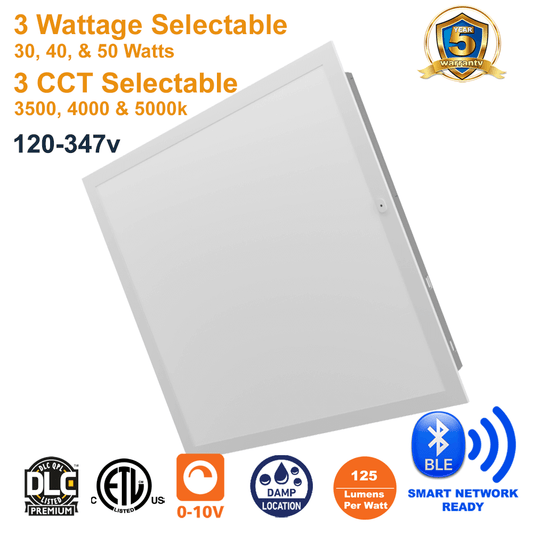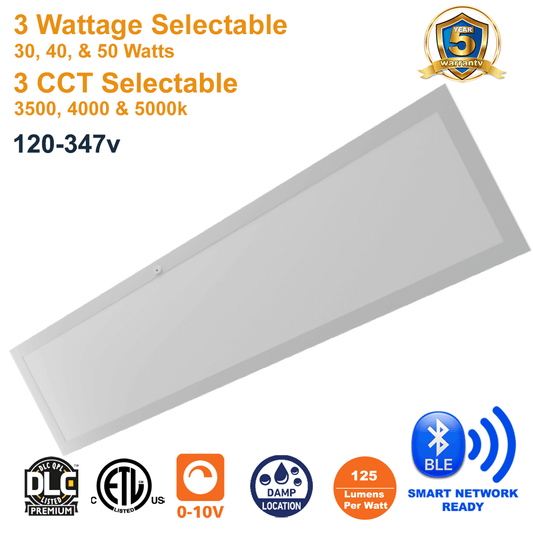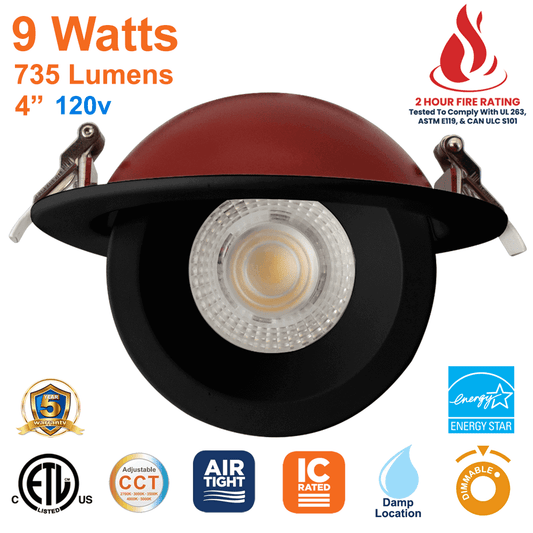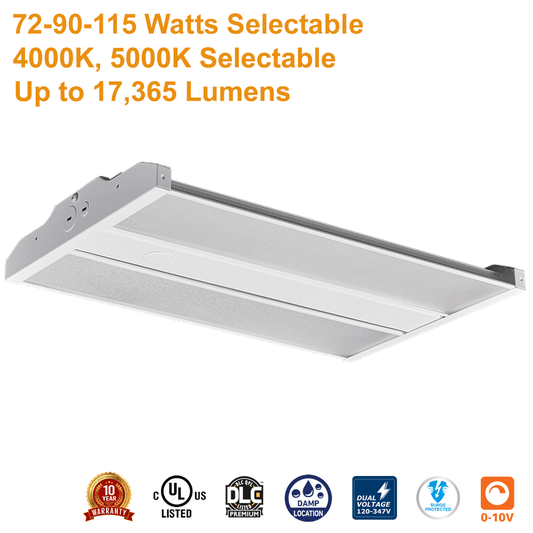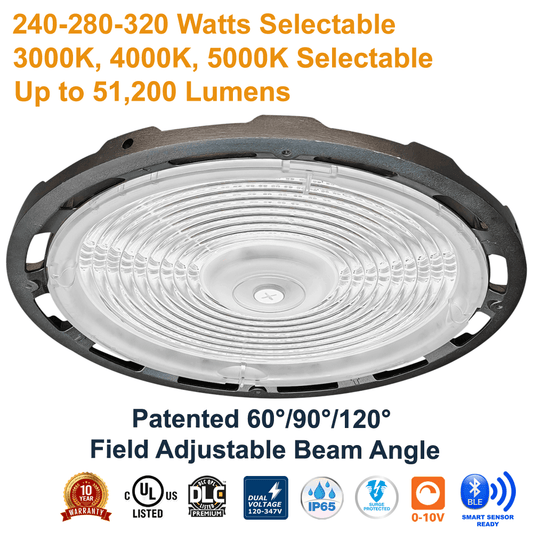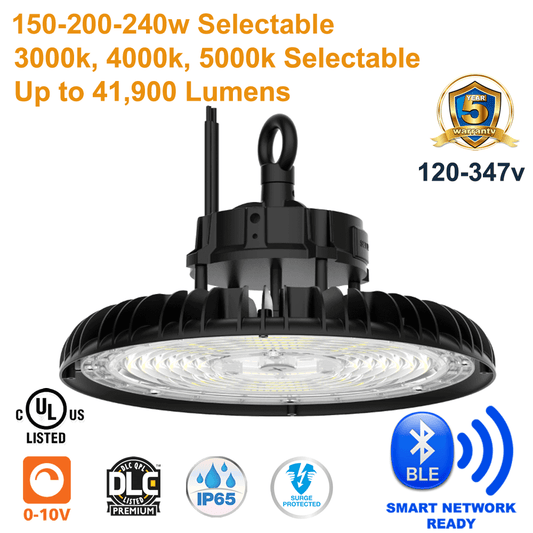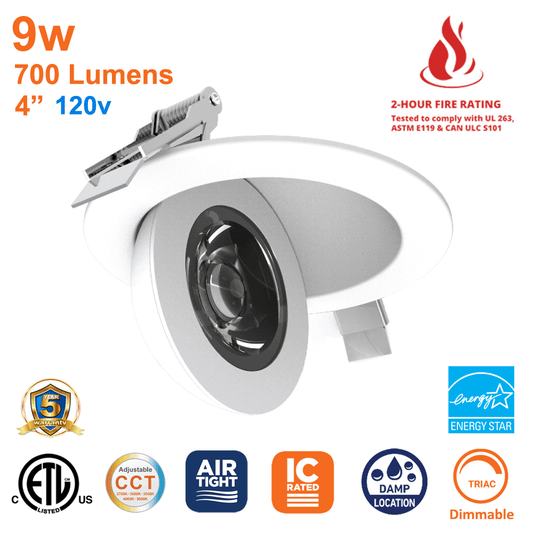Fast Facts – What You’ll Learn:
-
The three core bathroom zones and what lighting can safely be used in each.
-
Why IP Ratings and fire rated downlights matter in moisture-prone spaces.
-
How to choose between IP20, IP44, IP65, IP67, and IP68 based on zone placement.
-
The link between Building Regulations (Part P) and Residual Current Devices (RCDs).
-
Safety insights on electric shock risk, submersion ratings, and ingress protection standards.
-
Recommendations on LED downlights and integrated LED options for wet environments.
-
Expert picks from LEDNetwork.ca for recessed lighting that complies with Canadian and international standards.
Bathrooms aren’t just functional spaces—they’re also high-risk environments for lighting if you don’t get it right. With the rising demand for modern bathroom aesthetics, recessed lighting and sleek LED fixtures are becoming increasingly common. But while choosing a stylish design is easy, ensuring it’s safe for wet zones is another story.
This is where understanding Bathroom Zones and Fire Rated Downlights comes in—and why IP Ratings aren’t just numbers, but essential safety standards.
Understanding Bathroom Zones: Defined by Risk, Not Aesthetics
Bathrooms are split into zones—Zone 0, Zone 1, and Zone 2—each defined by their proximity to water and therefore the level of ingress protection required.
“Bathroom lighting must be as resistant to water as it is aesthetically pleasing.”
Zone 0
-
Where: Inside the bathtub or shower tray.
-
Requirements: IP67 or higher, allowing temporary submersion.
-
Lighting Type: Low voltage (SELV) only.
Zone 1
-
Where: Directly above the shower or bath, up to 2.25 meters.
-
Requirements: Minimum IP44, though IP65 is commonly used for added protection.
-
Lighting Type: Fixtures must be fully sealed against moisture splashes and steam.
Zone 2
-
Where: 0.6 meters around the bath or shower perimeter and up to 2.25 meters high.
-
Requirements: Also minimum IP44, with steam resistance being critical.
-
Lighting Type: Ideal for recessed fire-rated LED pot lights.
Outside these zones? No IP rating is legally required, but moisture resistance is still highly recommended.
Why IP Ratings Matter More Than Ever
The IP rating, or Ingress Protection rating, is a two-digit code that defines how well a fixture is protected against solids and liquids.
| IP Rating | Solid Protection | Water Protection | Usage Example |
|---|---|---|---|
| IP20 | Touch-proof (fingers) | None | Dry areas like bedrooms |
| IP44 | Objects >1mm | Splashes from all directions | Zone 1 & 2 |
| IP65 | Fully dust-tight | Water jets | High-moisture zones |
| IP67 | Dust-tight | Temporary immersion | Zone 0 |
| IP68 | Dust-tight | Continuous immersion | Pools, fountains |
The first digit refers to solid protection level (e.g., dust), and the second digit relates to water protection level. This is based on standards outlined in IEC 60529, often tested in an approved test laboratory.
Explore our Fire Rated Pot Lights Collection to browse IP-rated options suitable for all bathroom zones.
The Role of Fire Rated Downlights: Safety Meets Performance
Bathrooms aren’t just humid; they’re enclosed. This raises another concern—fire containment. If a fire breaks out, unprotected holes from downlights can compromise the ceiling's fire barrier. That’s why fire rated downlights are crucial, especially in multi-storey homes or residential complexes.
We recommend our 4-Inch Fire Rated Pot Light featuring:
-
IC rating (safe with ceiling insulation)
-
Wet-rated design for Zone 1 and Zone 2
-
2-hour UL263 fire rating
-
Selectable CCT for custom ambience
These products comply with both Part P Building Regulations and modern wiring regulations, ensuring electrical safety while maintaining visual appeal.
Bathroom Lighting: Where Design Meets Regulation
Modern bathrooms demand lighting that performs just as well as it looks. Yet so many overlook vital details like:
-
Vapour barriers to prevent condensation intrusion.
-
Ceiling cut-out dimensions for safe installations.
-
Thermal protection to prevent overheating in insulated ceilings.
Choosing the right product is not just about style—it's about meeting Lighting Zones regulations and electrical load capacity.
For compact bathrooms or minimalist aesthetics, our 3-Inch Fire Rated Pot Light provides discreet yet high-performance lighting that meets all fire and ingress protection criteria.
Installation & Safety: Beyond the Rating
Choosing an IP-rated or fire-rated downlight is just the start. Correct installation plays an equal role in ensuring lighting safety, especially in moisture-prone areas. From sealing fixtures to proper wiring, everything matters.
Key Safety Considerations for Bathroom Lighting
1. Residual Current Devices (RCDs) Are Mandatory
According to Building Regulations Part P, all bathroom circuits must be protected by a 30mA RCD. This device detects electrical leakage and cuts power within milliseconds, reducing the electric shock risk significantly.
2. Verify Wiring Regulations
Older homes may not comply with current codes. Before retrofitting lights, verify:
-
Circuit integrity
-
Grounding requirements
-
Compatibility with dimmable LED drivers
3. Confirm Zone Protection Requirements
Always match the light’s IP rating with the zone it’s installed in. Overprotecting is fine, but underprotecting isn’t an option.
“An IP65 spotlight is a safe all-rounder for Zone 1 or 2, even when exposed to steam.”
4. Use Proper Ceiling Protection
Insulated ceilings require IC-rated fixtures. Our 6-Inch Fire Rated Pot Light includes:
-
15W power output with 1100 lumens
-
5 CCT selectability for ambience tuning
-
Wet-rated for bathroom zones
-
IC-rated housing compatible with ceiling insulation
This light is ideal for bathrooms with low ceilings, recessed lighting requirements, or thermal protection demands.
Moisture Resistance vs. Waterproofing: Know the Difference
Not all water-exposed areas are created equal. That’s why understanding the difference between moisture-resistant and waterproof lighting is essential.
Moisture-Resistant Lights
-
Typically rated IP44–IP54
-
Ideal for Zone 2 or covered outdoor spaces
-
Resistant to splashing and steam ingress
Waterproof Lights
-
Start at IP65 and go up to IP68
-
Can resist jets of water, heavy splashing, or full submersion
-
Essential for:
-
Shower lighting
-
Bathtub zone lighting
-
Outdoor light fittings
-
Pool lighting or underwater lighting
-
Use our Fire Rated Pot Lights to match various levels of Ingress Protection to your desired location.
Hidden Challenges in Bathroom Lighting
Even with all the ratings and codes in place, some challenges require attention to detail:
Vapour Barriers and Condensation
Without proper sealing, water vapor can infiltrate ceiling cavities. Over time, this causes:
-
Rusted fixtures
-
Short circuits
-
Reduced lifespan of integrated LEDs
A fixture with steam resistance and a fully sealed driver unit will minimize this risk.
Electrical Load Capacity
Don’t overload circuits with high-lumen or multi-light installations. Calculate wattage to avoid tripping RCDs or overheating.
Recessed Lighting Placement
Maintain safe distances from:
-
Water outlets
-
Bathroom fans
-
HVAC ducts
For example, our 4-Inch Fire Rated Pot Light is an ideal size for clustered recessed layouts without violating lighting zones regulations.
Bathroom Lighting Zones in Practice: A Quick Reference Guide
| Zone | Minimum IP Rating | Fixture Type | Notes |
|---|---|---|---|
| Zone 0 | IP67 | SELV LED Downlight | Full submersion-safe |
| Zone 1 | IP44 (preferably IP65) | Fire Rated Pot Light | Splash and steam-proof |
| Zone 2 | IP44 | Integrated LED Downlight | Moisture-resistant |
| Outside Zones | IP20+ | Ambient Lighting Fixtures |
Standard use |
Design Meets Safety: Future-Proofing Your Bathroom Lighting
Gone are the days when bathroom lighting was purely functional. Today, homeowners want design, ambience, and compliance wrapped into one fixture. With evolving trends in shower-safe lighting, ambient lighting, and recessed fixtures, it's now possible to achieve a high-end look while adhering to the strictest lighting zones regulations.
How to Achieve a Harmonious Lighting Design in Wet Environments
Use this approach to blend form and function in your lighting layout:
1. Layer Your Light
Combine:
-
Ceiling light fixtures for general lighting
-
IP65 spotlights in wet zones for task lighting
-
Indirect LED strips for soft ambient glow
2. Match IP Ratings to Aesthetic Needs
Rather than compromising on design for safety, select from multi-CCT fire-rated LED options that let you change the tone and feel of the space.
For example, our 3-Inch Fire Rated Pot Light offers:
-
A slim profile perfect for compact or modern bathroom designs
-
Full dimmability to enhance mood
-
Safety for Zones 1 and 2
-
Compliance with UL263 fire rating standards
3. Use Uniform Fixtures Throughout
Consistency in IP ratings and fixture styles across the ceiling prevents a disjointed appearance—and reduces future maintenance by ensuring moisture resistance across all zones.
Building Code Compliance Checklist
Before finalizing your installation, review this quick checklist to avoid costly rewiring or failed inspections:
-
All fixtures in Zone 0 rated IP67 or higher
-
Zone 1 lights are at least IP44, preferably IP65
-
Zone 2 fixtures are IP44+ and installed within 0.6m of wet areas
-
Lights are IC-rated if near or touching insulation
-
All circuits protected by a 30mA Residual Current Device (RCD)
-
Fire-rated fixtures meet 2-hour fire rating (UL263 or equivalent)
-
Use of Safety Extra Low Voltage (SELV) in Zone 0
-
Proper ventilation to reduce steam accumulation
-
Follow IEC 60529 ingress rating guidelines
Why Choose LED Network?
At LED Network, we design lighting solutions that aren’t just technically compliant—they’re crafted for real-world environments. From damp-rated fixtures for modern homes to fire-rated LED pot lights for builders and contractors, we offer a curated selection of products backed by industry certifications and trusted performance.
You can explore our full collection of Fire Rated Pot Lights to find lighting that:
-
Matches your bathroom’s ceiling insulation requirements
-
Delivers thermal protection
-
Meets Canadian electrical standards and UL/ETL listings
-
Includes CCT-selectable, wet-rated, and low-profile options
“IP ratings and fire safety aren’t just about compliance—they’re about protecting your home, your family, and your investment.”
Whether you're renovating a small powder room or designing a spa-like retreat, understanding Bathroom Zones and Fire Rated Downlights will help you make smarter, safer lighting choices.
Ready to Upgrade Your Bathroom Lighting?
Browse our handpicked, tested, and certified solutions today:
Need help choosing the right IP rating or confirming your bathroom IP zones? Our lighting experts are just a click away.
Frequently Asked Questions
About Bathroom Zones and Fire Rated Downlights: The IP Ratings You Need
1. Do I need fire-rated downlights in every bathroom, or only in multi-storey homes?
While fire-rated downlights are required where a ceiling acts as a fire barrier—such as between floors in a multi-storey home—it’s good practice to use them in all bathrooms. They enhance fire containment and future-proof your installation, especially in areas with ceiling insulation.
2. Are IP-rated downlights suitable for use outdoors as well as in bathrooms?
Yes. Many IP65 or higher-rated lights are suitable for outdoor light fittings as well as bathrooms. Just make sure they are also rated for UV resistance and temperature extremes if installed outdoors.
3. Can I use IP44 lights in a shower enclosure if they’re not directly above the water?
Only if the light is installed within Zone 2 of the bathroom. For any light directly above a shower or in Zone 1, IP65 or higher is strongly recommended to withstand steam and water splashes.
4. Are all fire-rated lights also IP-rated?
No. A fire rating and an IP rating serve two different safety functions. A fire rating refers to how long the fixture can resist fire (e.g., UL263 2-hour rating), while an IP rating deals with ingress protection against solids and liquids. Look for fixtures that are both fire-rated and wet-rated for bathrooms.
5. What is the difference between IC-rated and fire-rated downlights?
-
IC-rated fixtures can be safely covered with thermal insulation in the ceiling.
-
Fire-rated downlights are designed to seal holes in the ceiling, maintaining the integrity of fire compartments.
Some products (like ours) combine both for maximum safety and efficiency.
6. Can I retrofit my current non-IP lights with IP-rated covers or housings?
In some cases, yes—but it’s not ideal. Retrofitting may compromise the fixture’s heat dissipation or violate manufacturer warranties. It’s best to replace the entire unit with properly certified IP-rated downlights designed for moisture-prone areas.
7. Are recessed downlights better than surface-mounted ones for bathrooms?
Recessed lighting offers a cleaner aesthetic and is less likely to interfere with steam flow or airflow. However, ensure that vapour barriers, gaskets, and proper sealing are used to prevent condensation build-up in the ceiling void.
8. Can I use a dimmer switch with fire-rated bathroom lights?
Absolutely—just ensure the LED downlights are dimmable and the dimmer switch is LED-compatible. Many of our bathroom-ready products offer 5 CCT selectability and dimmability to control both mood and energy use.
9. What happens if I install the wrong IP rating in the wrong zone?
Installing a fixture with an insufficient IP rating could result in:
-
Short circuits
-
Premature failure
-
Invalidated insurance or building warranties
-
Increased electric shock risk
Always follow Lighting Zones regulations and IP rating guidelines from the IEC 60529 standard.
10. Do fire-rated lights require maintenance or inspection over time?
Fire-rated downlights are designed to be maintenance-free, but periodic checks during general electrical inspections are advised. Look for:
-
Signs of moisture ingress
-
Failing seals or gaskets
-
Discoloration or corrosion on metal parts
These could indicate an issue with steam resistance or an improper installation.





